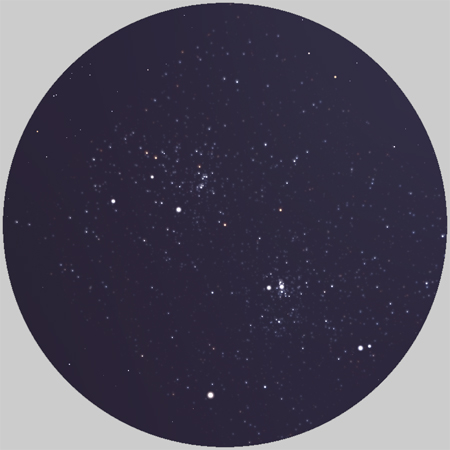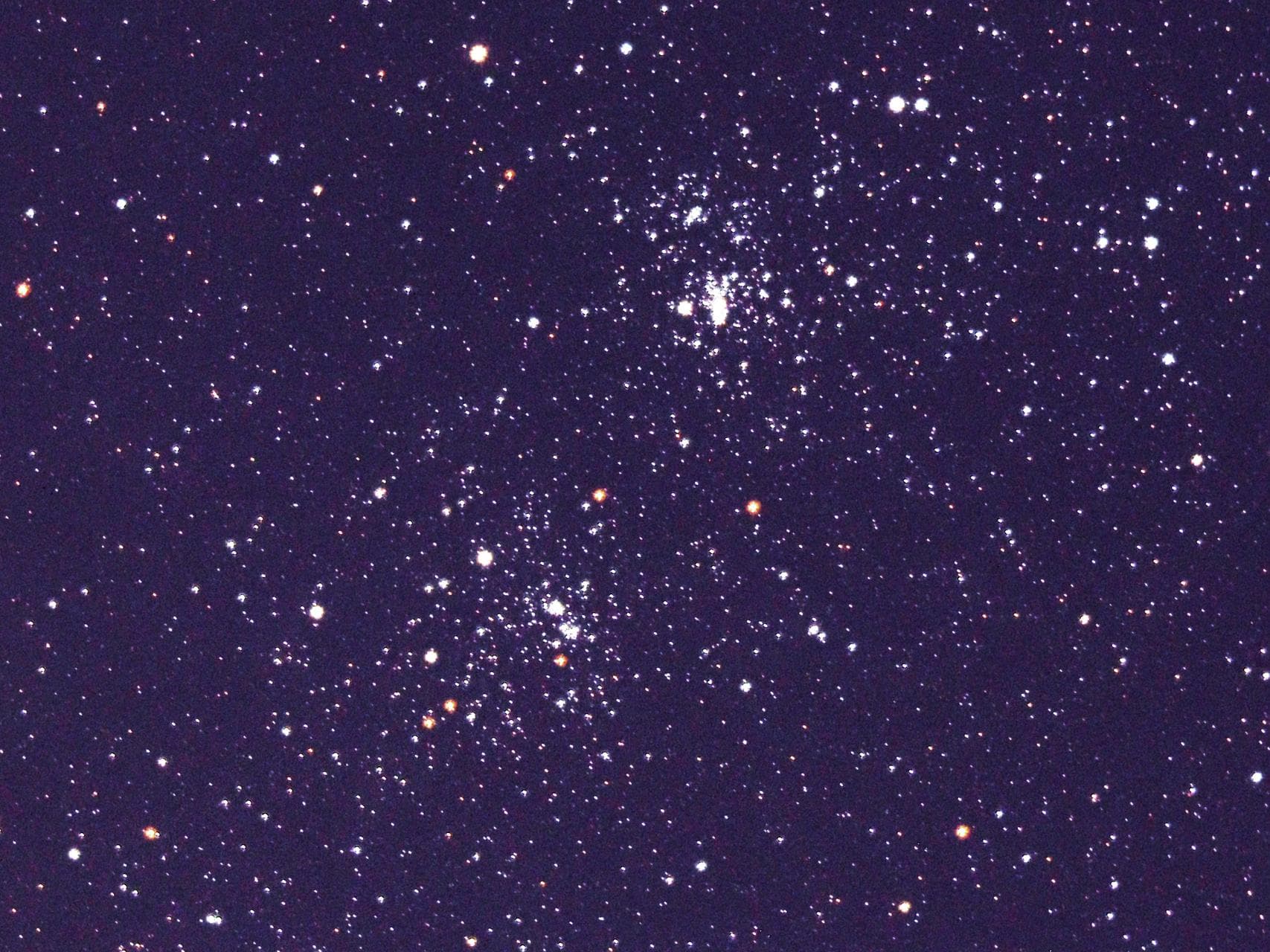The Double Cluster (NGC 869 & NGC 884)
A detailed guide to finding / observing the two open clusters
TOTS #5 is a detailed written and video reference to finding and observing the two open clusters NGC 896 & NGC 884 better known as the Double Cluster in the constellation of Perseus. This guide is ideal for beginners, but many advanced amateur astronomers may find it useful. This guide will help you locate these two open clusters whether your telescope has a magnified finderscope or a red dot finder.
Visitors who are new to this site may wish to get started here or if you are already familiar with telescopes and equipment but aren't sure where to get started, check out the Shapes in the Sky section on this site. The Cassiopeia video in particular will help you get in the right area of the night sky to locate this object.
Find NGC 869 and NGC 884 in the sky
NGC 869 and NGC 884 are two open cluster within our own Milky Way galaxy that are very close to each other, creating a "dual" cluster for telescope observers. The two clusters are each about 7,500 light years from Earth, so the photons from it reaching your eye in a telescope left that cluster about the time copper was being used in the Middle East. The estimated age is about 12.8 million years, making it one of the younger star clusters in our galaxy. Here is a detailed guide on how to locate the Double Cluster.
Observing tips:
After the Pleiades, the Double Cluster is perhaps the best open cluster to observe in a telescope - well, two open clusters! Both of them are easily visible in most larger finderscopes even from moderately light polluted locations.
Once located, these clusters are very large in the eyepiece for many telescopes. Use the lowest magnification possible (long focal length eyepiece). Shorter focal ratio telescopes (f4 to f6) will better be able to provide the wide telescopic field of view necessary to see both together, while longer focal ratios (f8 and longer) will likely require eyepieces with significant apparent fields of view.
Lacking that expensive eyepiece glass, try viewing each cluster independently of the other. NGC 869 is the cluster with the more densely populated central region, and is also the one slightly closer to Cassiopeia. To enhance your view and see more stars, center this cluster and add a bit more magnification, to a medium-magnification eyepiece. This can darken the sky background and appear to provide a bit more contrast, pulling out a few more of the fainter stars in the cluster.
Useful filter(s): Broadband light pollution filters may be useful in moderate to larger sized telescopes (114mm or larger) but only to darken the sky background at lower magnifications. The filter will also dim the brightness of the stars, so the benefit may be minimal or non-existent.
What should I see?
Photographs show much more of night sky objects because they can capture more photons for longer periods of time. As such, sketches of deep sky objects are perhaps one of the better ways to see what you might expect to observe at the eyepiece, because it is a rendering of what another observer's view was. Here's some links to some sketches of this object:
Because telescopes and observers are all different, here are some alternate sketched/drawn views of the Double Cluster:
Ferenc Lovró, using a 12" f/5 reflector
Jeremy Perez, using a 6" f/8 reflector
Below is an approximate view NGC869 and NGC884 as seen with a 70mm telescope at 38x magnification, and a 1.4 degree telescopic field of view.

Demonstrates how view would look with objects on the meridian using a refractor telescope and a star diagonal. Other telescopes or object sky positions may incur a differing view. Various magnifications, eyepieces, telescope focal lengths and other variables may alter the view compared to this one. This is a representation only intended to help the observer get some idea what they may see at the eyepiece. Extreme local light pollution will significantly diminish the number of fainter stars visible.
Details of NGC 869
Type: Open Cluster
Distance: 7,500 light years
Apparent dimensions: 30 arc minutes
Apparent magnitude: 3.7
Right ascension: 02h 19m 0s
Declination: +57 09' 0"
Details of NGC 884
Type: Open Cluster
Distance: 7,500 light years
Apparent dimensions: 30 arc minutes
Apparent magnitude: 3.8
Right ascension: 02h 22m 0s
Declination: +57 08' 0"
Here are some other nearby Telescopes On The Sky objects you can find and observe with any small telescope:
Messier 34 (open cluster)
More about this constellation
Name of constellation: Perseus
Abbreviation: Per
Genetive form: Persei
Common names: The Hero
Associated asterisms: No major ones
Original 48 of Ptolemy: Yes
Area by size: 615 square degrees
Relative size: 24 out of 88 (Serpens is next larger, Cassiopeia is next smaller)
Telescopes on the Sky objects that can be found in this constellation: Messier 34, Double Cluster
Brightest stars, in order of magnitude
First lists the Bayer designation, then the "traditional" star name (often Arabic, but not always - see each star's notes for details). Graphic shows constellation at zenith as if looking up with body facing north.
-
α (alpha) Persei (Mirfak) magnitude 1.79, is the 37th brightest star in the sky. It is 510 light years away from us. The traditional name is derived from the Arabic Mirfaq al-Thurayya, which means, "the elbow."
-
β (beta) Persei (Algol) is an eclipsing variable star of 2.1 that dips to 3.4 every 2.86 days. At maximum, it is the 59th brightest star in the sky. Traditional name is from the Arabic رأس الغول ra's al-ghūl : head (ra's) of the ogre (al-ghūl) - or "ghoul."
-
ζ (zeta) Persei is magnitude 2.84, and about 750 light years from Earth.
-
ε (epsilon) Persei is magnitude 2.88, and approximately 640 light years distant.
-
γ (gamma) Persei is an eclipsing binary system, with an combined magnitude of 2.93, and around 243 light years distant.
-
δ (delta) Persei is magnitude 3.01 and is 520 light years away.
-
ρ (rho) Persei is magnitude 3.39 and is 308 light years distant.

